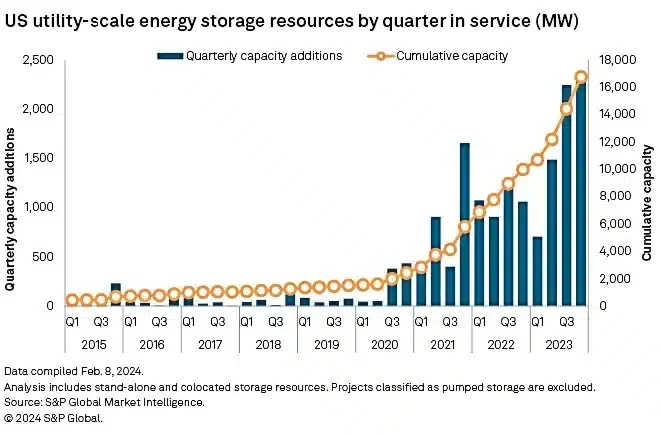Amidst a backdrop of growing electric vehicle adoption and shifting dynamics in the lithium market, the landscape of energy storage in the US is rapidly evolving. With record-breaking installations of lithium-ion battery arrays and notable reductions in lithium prices, the sector is poised for significant transformation.
Unleashing the Power of Energy Storage
Energy storage developers are forging ahead, connecting unprecedented volumes of lithium-ion battery arrays to the US power grid. About 6.8 GW of new large-scale battery capacity was added in 2023, a 59% increase from 2022, according to S&P Global Market Intelligence.
These projects store electricity primarily for one to four hours and are often co-located with renewable or fossil-fueled power plants. They include over 120 installations, with California, Texas, and the greater Southwest leading the expansion. Together, they bring total non-hydroelectric storage resources to about 17 GW.
According to Market Intelligence data, California leads with 8,179 MW of operating batteries, followed by Texas with 4,252 MW, as of Feb. 8. Arizona ranks third with 858 MW, trailed by Nevada with 758 MW and New York with 232 MW. The battery storage pipeline is also expanding in states like Oregon, Indiana, and Wisconsin, signaling broader growth beyond the Southwest-centric focus.
In 2024, an impressive 34 GW of big battery resources will come online, with over 10 GW under construction. However, development timelines often need to catch up, with delays throughout the year.
S&P Global Commodity Insights anticipates 4.2 GW of firm projects in 2024, forecasting a total installed battery power storage capacity of 23 GW by the end of 2025. This robust growth underscores the pivotal role of energy storage in America’s transition to a sustainable energy future.
Breaking Records, Building Resilience
Despite project delays, developers achieved a record-breaking quarter in the last three months of 2023. They have installed 2,332 MW for that period, doubling the previous year’s figure and surpassing the 3rd quarter’s record.
The largest completion was Terra-Gen LLC’s Edwards & Sanborn solar-plus-storage complex in Southern California. The project boasts 971 MW/3,287 MWh of storage and 800 MW of solar capacity. Other notable completions include Plus Power’s 300-MW/600-MWh Rodeo Ranch Battery Storage in Texas.
These achievements in lithium-ion battery storage installations go hand-in-hand with the optimistic growth in the plug-in electric vehicle (PEV) market.
January saw PEV sales surge in key markets. China and the Europe-Top 4 markets recorded impressive year-over-year growth of 101.8% and 33.7% respectively. However, this growth pales in comparison to the January 2022 figures.
European policymakers have scaled back PEV incentives due to fiscal concerns, with Germany ending subsidies earlier than anticipated in 2023. In the US, stricter sourcing requirements have limited models qualifying for the EV tax credit. This negatively impacted best-selling models like the Ford Mustang Mach E and certain versions of the Tesla Model 3.
In response to subsidy cuts, automakers are shouldering subsidy costs themselves. Volkswagen AG is covering all subsidies in Germany until the end of 2024, while Stellantis NV is offering reduced subsidies in Q1 2024. Automakers are also slashing PEV prices to stimulate demand amidst reduced consumer appetite. Tesla Inc. and Ford Motor Co. have implemented price cuts in China, Europe, and the US.
Charged for Change: Challenges and Opportunities in the Lithium Market
Reduced battery costs, stemming from lower metal prices, have facilitated the price reductions. Lithium-iron phosphate cell production costs dropped by around 30% in 2023, with a further 20% reduction expected in 2024.
This environment has intensified competition, particularly in China, prompting PEV manufacturers to vie for market share aggressively. As the China Passenger Car Association notes, 2024 is pivotal for new energy vehicle companies, heralding fierce competition ahead.
As lithium prices continued to decline, reports of curtailed lithium mine operations heightened. This particularly affects junior miner-led hard-rock mines in the ramp-up phase. These projects face significant pressure due to the necessity of raising initial capital and maintaining cash flow, leaving little room for high-cost ventures.
Core Lithium halted open-pit mining at Finniss in Australia’s Northern Territory, while Liontown is delaying expansion plans at Kathleen Valley in Western Australia.
Meanwhile, Sayona Mining is reassessing its North American Lithium project in Quebec. But a junior Canadian lithium company, Li-FT Power (LIFT: LIFFF) works hard to help meet North American lithium demands.
Li-FT specializes in consolidating and advancing hard rock lithium pegmatite projects within Canada while targeting established lithium districts. The company is dedicated to advancing the exploration and development of top-tier lithium assets throughout the country.
Despite limited trading activities and the stabilizing of lithium carbonate prices, bearish sentiment persists over demand and prices. Speculation about further cuts in lepidolite mines in China boosted Australian mining stocks. It also does so with the price of the main lithium carbonate contract on the Guangzhou Futures Exchange.
As the US power grid evolves toward sustainability, the surge in energy storage installations marks a transformative step. With record-breaking battery installations and declining lithium prices, the landscape is ripe for innovation and growth.





